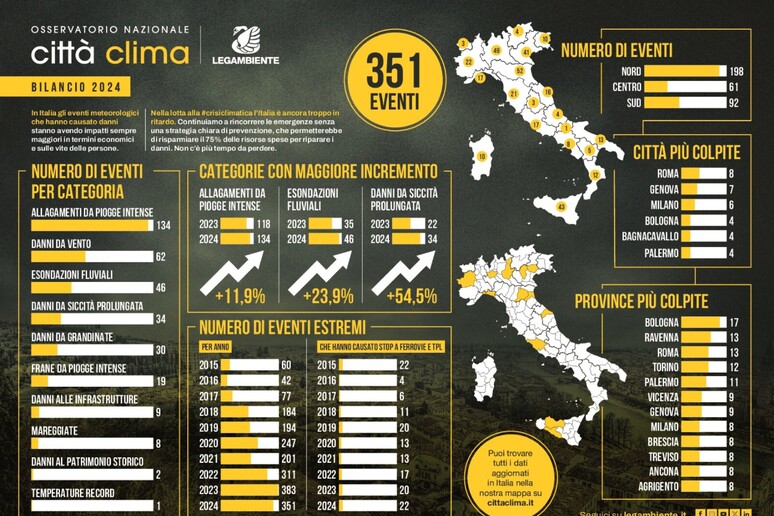There have been 351 extreme weather
events in Italy in the last 10 years, environmental group
Legambiente reported Monday, with an almost six-fold rise over
the last 10 years and the Emilia-Romagna region topping this
year with a wave of devastating and deadly floods.
"With prolonged drought, floods and heavy rains, Italy is
increasingly beset by the climate crisis," said the report from
the Legambiente Città Clima Observatory, created with the Unipol
banking group.
The number of extreme events has grown steadily over the last
ten years, the report said.
In 2024, extreme events were almost six times more than the 60
of 2015, marking an increase of 485%. "Emilia-Romagna was the
most tormented region, followed by Lombardy, Sicily, Veneto and
Piedmont," it said.
The report also contains a focus on transportation: there were
22 extreme weather events with damage and suspensions to trains
and local public transportation.
2024 was marked by 134 cases of flooding from heavy rains, 62
cases of wind damage, 46 river floods that caused damage, 34
events with damage from prolonged drought, 30 damages from
hailstorms, 19 cases of landslides caused by heavy rains, 9
damages to infrastructure, 8 from storm surges, 2 to historical
heritage and 1 case of record temperatures.
The damages from prolonged drought (+54.5% compared to 2023),
river floods (+24%) and floods due to heavy rains (+12%) saw the
greatest growth, with Italy divided in two between too little
and too much water.
Northern Italy is the most affected with 198 extreme weather
events, followed by the South with 92 and the Centre with 61.
At a regional level, this year Emilia-Romagna with 52 events is
the region most affected by the climate crisis, followed by
Lombardy (49), Sicily (43), Veneto (41) and Piedmont (22).
Among the provinces, Bologna stands out with 17 extreme weather
events, followed by Ravenna and Rome both with 13, Turin with 12
and Palermo with 11.
Among the large cities, the Capital is the most affected with 8
extreme weather events, followed by Genoa (7) and Milan (6).
As regards drought, the most affected regions were Sicily (16
events), Sardinia (9), Basilicata (3).
On the flooding front, Lombardy stands out (with 25 extreme
weather events), followed by Emilia-Romagna (22), Sicily (15).
In terms of river floods, Emilia-Romagna is in first place (with
14 events), followed by Lombardy (8), Veneto (5).
Also worrying is the damage that extreme weather events are
causing in general on transport: 22 of them in 2024 caused
damage and delays to trains and local public transport in the
Peninsula.
The report also recalls yet another global temperature record
recorded by the European Copernicus program, which indicates
2024 as the hottest year since records began, with, for the
first time, the threshold of 1.5 °C above pre-industrial levels
being exceeded.
And the effects, especially at high altitude, are increasingly
tangible, with impacts on glaciers, which are increasingly thin
and receding, ecosystems and biodiversity.
In 2024, in Piedmont, the freezing level at high altitude
reached 5,206 meters, almost matching the record set 9 years
ago, when it rose to 5,296 meters. "In 2024, Italy - says
Legambiente national president Stefano Ciafani - was overwhelmed
by a new wave of extreme weather events and once again found
itself unprepared. The Meloni Government, in over two years of
activity, has not implemented any prevention strategy with
targeted interventions, which would save 75% of the resources
spent to repair the post-emergency damage, and has not allocated
the necessary funding for the priority actions of the Pnacc,
funds not even foreseen in the recently approved budget law. It
is urgent to also approve a law to stop land consumption, a
problem addressed ideologically with the Agriculture Decree by
banning ground-mounted photovoltaics, and the Presidential
Decree to facilitate the reuse of purified wastewater on
agricultural land".
What is particularly worrying, says Legambiente's scientific
director Andrea Minutolo, is the phenomenon of drought:
"The symbol of this summer is Lake Pergusa, in the province of
Enna, reduced more or less to a puddle. The emergency in Sicily
is the result of the drought of the Po in 2022 and of a trend
linked to the ever-evolving climate crisis that represents a
severe warning. For this reason, it is important that the
country defines a national water management strategy, more
careful and circular, with concrete interventions that favor
adaptation to climate change and allow us to immediately reduce
water withdrawals, also avoiding waste".
ALL RIGHTS RESERVED © Copyright ANSA











